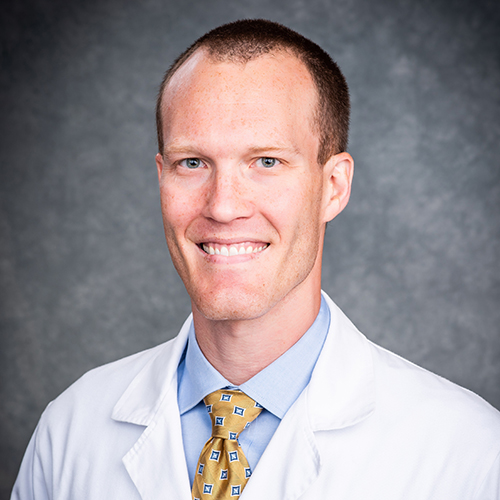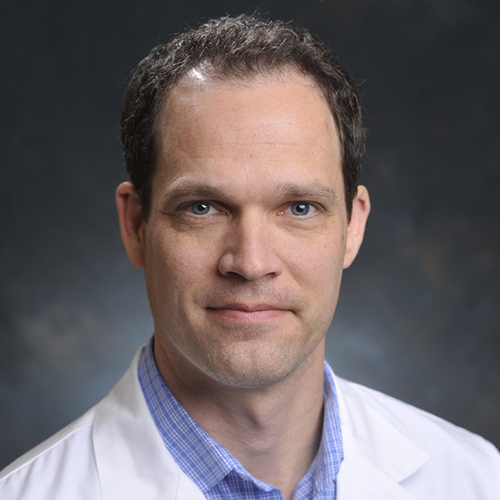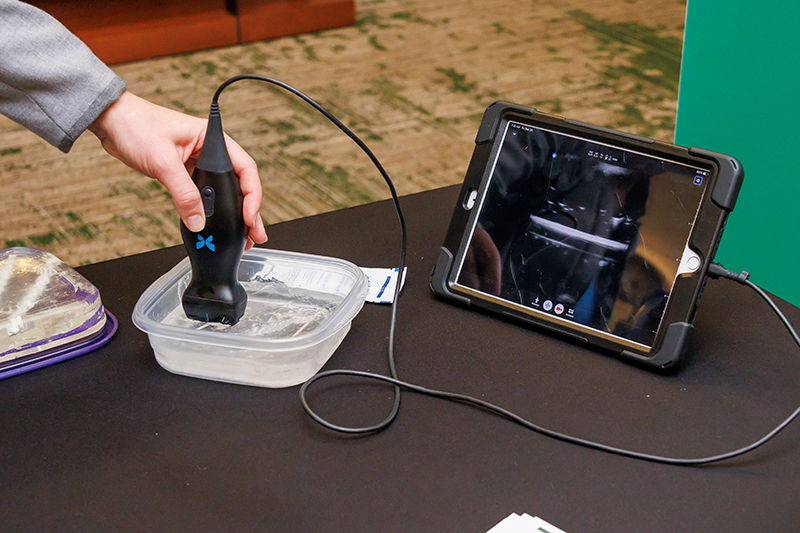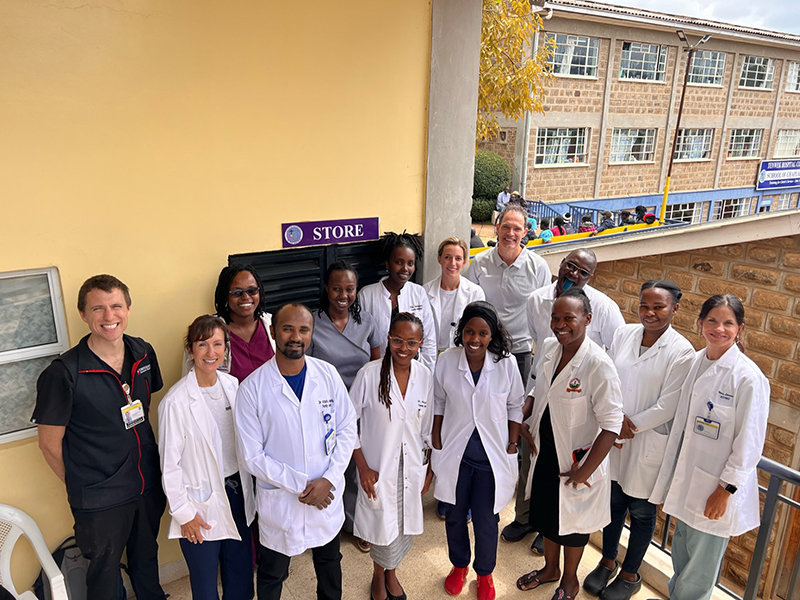 Luke Burleson, M.D., assistant professor in the Department of Emergency Medicine and program director of the Point-of-Care Ultrasound in Resource-Limited Settings (PURLS) fellowship, and Matthew Larrison, M.D., professor in the Department of Radiology, have implemented a Point-of-Care Ultrasound curriculum for family practice residents in Kenya.
Luke Burleson, M.D., assistant professor in the Department of Emergency Medicine and program director of the Point-of-Care Ultrasound in Resource-Limited Settings (PURLS) fellowship, and Matthew Larrison, M.D., professor in the Department of Radiology, have implemented a Point-of-Care Ultrasound curriculum for family practice residents in Kenya.
Burleson instructs medical students, residents, and fellows in point-of-care ultrasound and global emergency medicine. He has worked and taught clinically in East and West Africa, Southeast Asia, as well as Central and South America.
“My area of focus is point-of-care ultrasound (POCUS) in resource-limited settings, particularly in the tropics and the developing world,” said Burleson. “I came to this focus as a natural evolution from my emergency medicine training, where we often use point-of-care ultrasound for critically ill and undifferentiated patients.”
Larrison joined the team to develop POCUS curriculum, bringing extensive ultrasound teaching experience through a non-profit organization called Hope Imaging and mutual contacts at Tenwek Hospital in Kenya.
We sat down with Dr. Burleson and Dr. Larrison to gain insight into their lives and work in global health.
Q: What led you to your focus area?
 Luke Burleson, M.D.Burleson:
Luke Burleson, M.D.Burleson:
As I gained experience working clinically internationally, I realized how POCUS is even more valuable where access to other diagnostic imaging is lacking. I had several outstanding mentors in residency and fellowship who helped me gain practical skills and experience and develop a vision for combining emergency medical care and education in low-resource settings with point-of-care ultrasound.
Larrison:
My Christian faith has been the main motivation to assist in the training of health care providers in low-resource countries. Because of the love and grace Jesus has shown me, I am compelled to show His love to others. This includes using the gifts and skills I have. So, helping to train providers in a skill that will improve patient care is a way to leverage what I do professionally to have a larger impact.
Q: How did you connect with UAB?
Burleson:
I came to UAB for my residency training in Emergency Medicine, and then stayed for my fellowship in Point-of-care Ultrasound in Resource-Limited Settings through the Department of Emergency Medicine.
Larrison:
I attended UAB for medical school, completed my residency training in Diagnostic Radiology, and joined the musculoskeletal imaging section as an assistant professor in UAB’s Department of Radiology following a fellowship with Radiology Associates of Birmingham.
Q: How did you connect with your global partners?
 Matthew Larrison, M.D.Larrison:
Matthew Larrison, M.D.Larrison:
The director of the Family Residency program at Tenwek Hospital Kenya reached out to me, interested in developing a POCUS curriculum within their training program.
Burleson:
The Department of Emergency Medicine and our Global Emergency Medicine office have had an ongoing relationship with Tenwek Hospital in Kenya for almost 15 years. We send physicians there to work clinically and train Kenyan resident physicians and clinical officers and have developed multiple education initiatives with the local staff there. One of our fellowship alumni is currently living and working there full-time.
Q: What are the big issues in your focus area?
Larrison:
We provide on-site training in POCUS to clinics and hospitals that have limited access to this sort of training. In most of these places, access to medical imaging is non-existent or very limited.
Burleson:
As useful as POCUS can be in resource-limited settings, there are several barriers to its widespread use. First is the availability of the technology itself, in the form of reliable ultrasound machines. Thankfully, great strides have been made in the last few years, with a wide variety of ultraportable or handheld ultrasound systems that are easily transportable and much cheaper than traditional ultrasound machines. These systems are often easier for health care institutions and personnel in resource-limited settings to acquire. Another significant issue is that of quality training for POCUS. As with most medical procedures, developing competency in POCUS requires training, practice, and time, and this training is often not yet standardized or built into existing curricula. That is why I focus a big part of my effort in this area on the development of curricula, training programs, and quality assurance in POCUS in resource-limited settings.
Q: What is innovative about your work?
 Portable ultrasound machineLarrison:
Portable ultrasound machineLarrison:
Our attempt to create a self-sustaining POCUS training program in a low-resource setting is somewhat untested.
Burleson:
There are several key innovations of our work in POCUS in resource-limited settings. One is the development of a formal, accredited fellowship that develops POCUS experts with dedicated training in tropical medicine and extensive clinical and teaching experience in low-resource and tropical settings. These leaders can then multiply efforts to train local partners and develop other training initiatives. This fellowship has also developed several educational tools and curricula for POCUS training, such as online textbooks.
Our current project in Kenya involves the development of a sustainable, context-specific POCUS training curriculum that is built into the current residency curriculum. This curriculum was built through a collaboration with UAB Emergency Medicine and Radiology physicians and our Kenyan Family Medicine partners, specifically developed with East African clinical scenarios in mind. We believe this curriculum will be reproducible in other similar settings and will develop local ultrasound leaders to further the training.
Q: What has been the impact of your work?
Larrison:
Our POCUS learners will gain the skills to diagnose and treat their patients with training.
Burleson:
The primary impact of our work with the PURLS fellowship has been our three graduates. One is now living, working, and teaching in Kenya, while the other two work and teach internationally regularly and are developing the POCUS curriculum for the Kenyan Family Medicine residency. The fellowship curriculum has been published in order to facilitate the formation of similar programs at other institutions, and publication has led to the recruitment of fellows from outside the UAB umbrella. The fellowship has also translated into the development of other continuing medical education programs for physicians of other specialties who want to develop their POCUS skills for use in low-resource settings.
The POCUS curriculum is in its first year of implementation, with nine residents currently being trained, and we plan to continue the curriculum in future years. We hope to continue to build and expand its impact in future years and through the development of local POCUS advocates and experts.
Q: What are your goals for the future of your initiatives?
 Taken at Tenwek Hospital in Bomet Kenya. Front row, right to left: Jonathan Swanson, M.D., Nancy Semon RDMS, Dr. Atnafu Alemayehu, Dr. Lydiah Ngigi, Sheila Mulwa, Dr. Eunice Ondego, Dr. Annette Onyango, Nancy Larrison, RDMS. Back row, right to left: Dr. Rwamba Murani, Dr. Fridah Kitur, Dr. Alida Iradukunda, Mary Beth Oglesby, M.D., Matthew Larrison, M.D., and Dr. John MwangiLarrison:
Taken at Tenwek Hospital in Bomet Kenya. Front row, right to left: Jonathan Swanson, M.D., Nancy Semon RDMS, Dr. Atnafu Alemayehu, Dr. Lydiah Ngigi, Sheila Mulwa, Dr. Eunice Ondego, Dr. Annette Onyango, Nancy Larrison, RDMS. Back row, right to left: Dr. Rwamba Murani, Dr. Fridah Kitur, Dr. Alida Iradukunda, Mary Beth Oglesby, M.D., Matthew Larrison, M.D., and Dr. John MwangiLarrison:
Our hope is others will be encouraged to partner with similar training programs in the future.
Burleson:
I hope to develop more experts in both point-of-care ultrasound and emergency care in low-resource settings to be able to develop and lead more training initiatives for front-line clinicians. My goal is for our current POCUS curriculum to successfully train family physicians in Kenya, and to develop local Kenya ultrasound leaders who can lead and grow the program. More broadly, I hope to expand and integrate POCUS education into more medical education settings to improve patient care.
Dr. Burleson and Dr. Larrison are looking for more trained clinicians to contribute to point-of-care ultrasound training and quality assurance in low-resource settings. Their team is also in need of additional portable ultrasound devices for trainees and investment from curriculum development experts. If you would like to connect with their team or would like your work highlighted by the Mary Heersink Institute for Global Health, reach out to